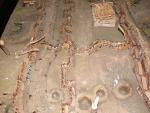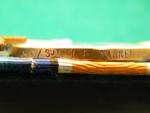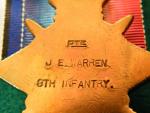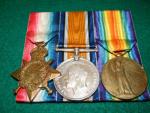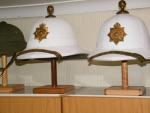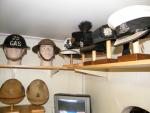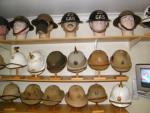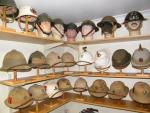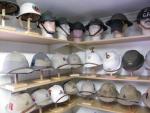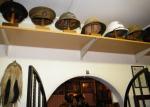James Edward Warren was born in Penzance, Cornwall in the United Kingdom on 14 July 1893. He was married and listed his wife, Mrs. D.P. Warren, a Durban resident, as his next -of-kin. He was listed as being a miner by trade. Our intrepid warrior saw very varied and interesting service throughout the major campaigns where South African forces fought during World War 1. He may hold the record for the number of military medical discharges and for a very varied and interesting number of reasons? GERMAN SOUTH WEST AFRICA 2ND BATTALION, TRANSVAAL SCOTTISH As No 5449, Warren attested in the 2nd Battalion of the Transvaal Scottish for service in the German South West African campaign. During this service, he was hit on the head by a so-called comrade in arms and was then diagnosed as being an epileptic. On 27 March 1915 he was medically discharged and classed as being unfit for further medical service. He had completed 178 days service and his conduct was noted as being "VERY GOOD". Warren was 20 years old at the time. WESTERN FRONT 4TH SOUTH AFRICAN INFANTRY REGIMENT (S.A. SCOTTISH) Totally disregarding his previous military and history, our man then attested in the 4th SAI on 19 August 1915. His force number was now No 886. It would appear as if he managed to convince the medical authorities that he was fit and healthy for active military service. Lo and behold, on 17 September 1915 he was again discharged for epilepsy and deemed unfit for active service in Europe. He had completed 31 days of service. GERMAN EAST AFRICA SOUTH AFRICAN VETERINARY CORPS At the age of 22, James decided to take his chances and joined the Union Defense Force for the German East African campaign. He attested on 12 November 1915 in the SAVC and was allocated the force No of 454. He proceeded to East Africa where he was charged for disorderly conduct and a breach of discipline. However, his medical "aptitude" had not yet left him. He suffered from a variety of illnesses which included tonsillitis, a hernia, orchitis and variascale counting. His luck really ran out when he was injured on "MOUNTED GRAZING DUTY". This injury resulted in the removal of one of his testicles! After being placed under observation for medical illness, he was again declared medically unfit for active and military duty and was discharged on 23 November 1916. He was accredited with 1 year and 9 days service and, despite being tried and found guilty for two offences, his conduct was again "VERY GOOD". WHAT NEXT: HOME SERVICE IN SOUTH AFRICA DURBAN Obviously bored at home, James then decided to further his military career by attesting at the Base Depot Company in Durban. He once again passed his medical examinations and attested on 12 December 1916 with the allocated force number of 135. Obviously bored, he was charged and found guilty on a number of offences of the Military Disciplinary Code. He was found guilty of being absent from a funeral parade; breaking out of camp and for overstaying his leave. There is no record OF any medical issues during this period of his military service. However, he was discharged on 16 February 1917 with 1 year and 61 days service. His conduct was described as being "GOOD". EUROPE AND FRANCE 1ST SOUTH AFRICAN INFANTRY BATTALION ( CAPE OF GOOD HOPE REGIMENT) With the war raging on the Western Front and the very large number of casualties experienced by the 1ST SOUTH AFRICAN INFANTRY BRIGADE, reinforcements were requested on a large number to replace the losses of this volunteer force. As Private Number 12215, James Warren attested for service in France on 16 February 1917. Our man once again succeeded in convincing the authorities that he was ready and fit for active service despite his negative medical and service record for the other World War One campaigns and units he had joined. Warren was soon up to his old tricks in France. He was charged and found guilty for being absent from barracks, making a false statement, overstaying his leave and for breaking out of hospital. In France, however, he was to participate in some actions and received the wounds to prove it. He received both a bayonet and bullet wound in his leg. A foreign body, believed to be shrapnel, was found is his left calf. Then the dreaded epilepsy struck again! On 2 October 1917, Pte Warren was discharged as being medically unfit! He had served 228 days and his conduct was described as being "VERY GOOD". MORE HOME SERVICE IN SOUTH AFRICA SOUTH AFRICAN NATIVE LABOUR CORPS After spending very little time at home in Durban, the veteran of three campaigns decided to once again enlist. He had attested in the South African Native Labour Corps a good month before he had officially been released from the 1ST SAI. This had taken place on 3 September 1917 and regardless of his previous military background and problems, he had been made a STAFF SERGEANT. His new force number was DD96. On 12 December 1917, Staff Warren decided to end his service and was discharged with 101 days service and conduct that was "VERY GOOD". 1ST SOUTH AFRICAN INFANTRY BRIGADE HOME SERVICE IN SOUTH AFRICA On 9 April 1918, Private Warren had again decided that his King and Country were in dire needs for his services. He attested as No 22546 and had again volunteered for service on the Western Front. In South Africa, he suffered from a "POISONED FINGER". He also reported suffering from "SHELL SHOCK". This again resulted in him being medically discharged as part of the General Mobilization on 20 May 1919. He was accredited with 1 year and 21 days service this time round and his conduct was "VERY GOOD". CONCLUSION Warren wore his medals with pride and as can be seen in the pictures he polished them often. This dedicated soldier may go down in history as being one of the most "attested" and "medical variety" in the Union Defense Force in World War 1.



